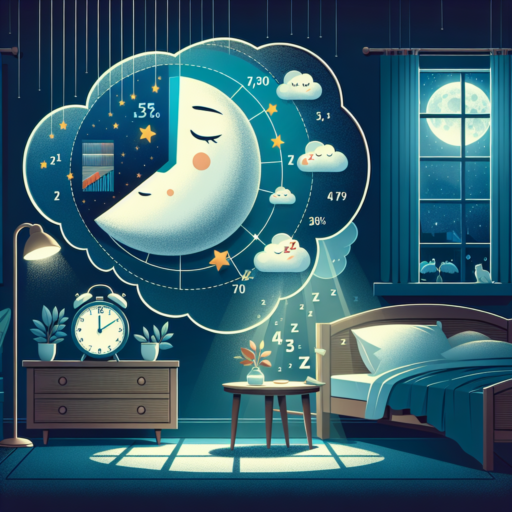No se han encontrado productos.
What is a healthy percentage of light sleep?
Understanding the composition of a good night’s sleep is crucial in recognizing the value of each sleep stage, including light sleep. Light sleep acts as a threshold between being awake and entering the deeper stages of sleep, playing a significant role in cognitive processing and memory consolidation. But, when quantifying a healthy percentage of light sleep, one must consider the complexities of sleep architecture.
Experts suggest that a healthy balance for adults is to have approximately 50% to 60% of their night spent in light sleep. This stage, scientifically referred to as N1 and N2 phases, encompasses the preliminary moments of falling asleep and the period before deep sleep. It’s during these phases that the body starts to relax, heart rate and breathing stabilize, and body temperature drops. A deviation from this healthy range may not necessarily indicate a problem but understanding one’s sleep patterns can provide valuable insights into overall sleep quality.
It’s also vital to acknowledge individual variability in sleep needs and patterns. Factors such as age, lifestyle, and overall health can influence how much light sleep one might need to feel rested and rejuvenated. For instance, children and teenagers often require more deep sleep due to the demands of growth and development, potentially altering the percentage of light sleep in their overall sleep cycle. Conversely, as people age, they might experience an increase in light sleep percentages, which is a normal part of the aging process.
Does light sleep still count as sleep?
Understanding the stages of sleep is crucial in comprehending why light sleep is considered an essential part of our sleep cycle. Light sleep, which encompasses Stage 1 and Stage 2 of the non-REM (Rapid Eye Movement) sleep, acts as a gateway to deeper sleep stages. It’s during these preliminary stages that our body begins to relax, with a decrease in heart rate, breathing, and brain activity.
Despite being on the lighter end of the sleep spectrum, light sleep plays a pivotal role in mental and physical restoration. It serves as a period of transition that helps in memory consolidation, a process where short-term memories are stabilized into long-term storage. Moreover, light sleep contributes to the regulation of our mood and cognitive functions, underlining its significance in overall health and well-being.
Arguably, light sleep may not feel as restorative as deep sleep or REM sleep, leading some to question its value. However, this stage of sleep aids in making up a larger portion of the night’s rest, ensuring that our bodies cycle through all stages of sleep multiple times. This cycling is critical for achieving a restful and restorative sleep experience.
Is 3 hours of light sleep enough?
Understanding the importance of sleep quality over quantity is crucial when evaluating if 3 hours of light sleep is sufficient for your body’s needs. Light sleep, while necessary, forms just one part of the complex sleep cycle, which also includes deep sleep and REM sleep. Each stage plays a vital role in ensuring our body and mind are rested and rejuvenated. Thus, relying solely on a short duration of light sleep might not provide the comprehensive benefits associated with a full sleep cycle.
The Role of Light Sleep in Overall Sleep Quality
During light sleep, our body begins to relax, and our heart rate starts to slow down. This stage serves as a transition period into deeper sleep stages, which are critical for physical recovery and memory consolidation. Although light sleep accounts for the majority of our sleeping hours, it is the combination of all sleep stages that contributes to overall health and well-being.
For individuals pondering whether 3 hours of light sleep is enough, it’s essential to consider the broader implications on health and cognitive function. Sleep deprivation, even if it’s mostly in light sleep stages, can lead to significant impairments in judgement, mood, and the ability to learn and retain information. Moreover, chronic sleep deprivation has been linked with a higher risk of certain diseases, including cardiovascular issues and diabetes.
What is the ratio of deep sleep to light sleep?
Understanding the ratio of deep sleep to light sleep is essential for comprehending our sleep patterns and the quality of rest we get each night. Generally, sleep can be broken down into several stages, ranging from light sleep to deep (or slow-wave) sleep, and finally, REM sleep. During a typical night, an individual will cycle through these stages multiple times.
Light sleep, which encompasses stages 1 and 2 of the sleep cycle, holds the lion’s share of our sleeping hours. It accounts for roughly 50-60% of total sleep in adults. This stage is characterized by slower brain waves and serves as a transition period to deeper sleep stages.
On the other hand, deep sleep, which includes stages 3 and occasionally 4, typically represents about 20-25% of a night’s rest for a healthy adult. Deep sleep is crucial for physical recovery, memory consolidation, and hormonal regulation. The remaining time is spent in REM sleep and brief moments of wakefulness.
Therefore, if we were to approximate a ratio of deep sleep to light sleep, considering the percentages mentioned above, it would lean more towards light sleep, with an average adult experiencing a ratio of approximately 1:2 to 1:3, deep sleep to light sleep. It’s important to note, however, that this ratio can vary significantly among individuals and changes with age.




